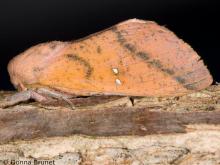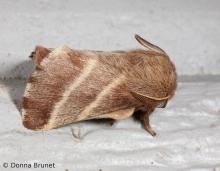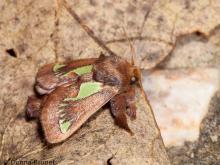Butterflies and Moths
Media

Species Types
Scientific Name
Catocala illecta
Description
The magdalen underwing is one of dozens in its genus found in Missouri. You can tell it from the others by the specific pattern on the brightly colored hindwings, which are usually covered by the dull brown forewings.
Media

Species Types
Scientific Name
Syssphinx bicolor (syn. Sphingicampa bicolor)
Description
Honey locust moths are gray in spring and increasingly yellow, tan, or rusty later as the season progresses. The hindwings are typically rose-colored.
Media

Species Types
Scientific Name
About 35 species in North America north of Mexico
Description
Tent caterpillar moths and lappet moths are medium-sized, with thick, long scales that make them look furry. The abdomen usually extends past the wings when they are folded back over the body.
Media

Species Types
Scientific Name
About 1,400 species in North America north of Mexico
Description
At rest, tortricid moths often have a distinctive shape, resembling an arrowhead or a bell, with the forewing tips either squared-off or flared outward.
Media

Species Types
Scientific Name
Euclea delphinii
Description
The spiny oak-slug moth is named for its caterpillar, which is armed with gaudy, stiff, stinging spines. If you touch them, the sting can feel something like a bee sting.
Media

Species Types
Scientific Name
Pediasia trisecta
Description
Sod webworms are very common small moths that develop as caterpillars among the roots and leaves of grasses. They are attracted to lights at night.
Media

Species Types
Scientific Name
Subfamily Herminiinae
Description
Litter moths are a subfamily of rather nondescript brownish moths, often with intricate patterns that camouflage them as they rest on tree bark or among leaves on the forest floor.
Media

Species Types
Scientific Name
Patalene olyzonaria
Description
The juniper-twig geometer is one of many geometrid moths that look like a dried-up leaf. Look for them around porch lights April through November. Larvae eat junipers, including eastern red cedar.
Media

Species Types
Scientific Name
Eacles imperialis
Description
The beautiful imperial moth is impossible to confuse with any other species in Missouri: the wings are yellow with spots and speckles of pink, orange, or rusty pale purple. Wingspan can be 5½ inches.
Media

Species Types
Scientific Name
Halysidota tessellaris
Description
Adult banded tussock moths have a distinctive checkered pattern on the wings. The fuzzy, dirty gray caterpillars are more familiar, with their pencils or tussocks of longer, black and white hairs.
See Also


Media

Species Types
Scientific Name
About 1,500 species in North America north of Mexico
Description
Adult caddisflies are mothlike. Their larvae are aquatic and build portable, protective cases out of local materials, including grains of sand, bits of leaves and twigs, and other debris.
Media

Species Types
Scientific Name
Corydalus cornutus
Description
Adult eastern dobsonflies are huge and mothlike, with large wings and a weak, fluttery flight. The fiercely predaceous aquatic larvae, called hellgrammites, are well-known to anglers, who often use them as bait.
About Butterflies and Moths in Missouri
Butterflies, skippers, and moths belong to an insect order called the Lepidoptera — the "scale-winged" insects. These living jewels have tiny, overlapping scales that cover their wings like shingles. The scales, whether muted or colorful, seem dusty if they rub off on your fingers. Many butterflies and moths are associated with particular types of food plants, which their caterpillars must eat in order to survive.





















